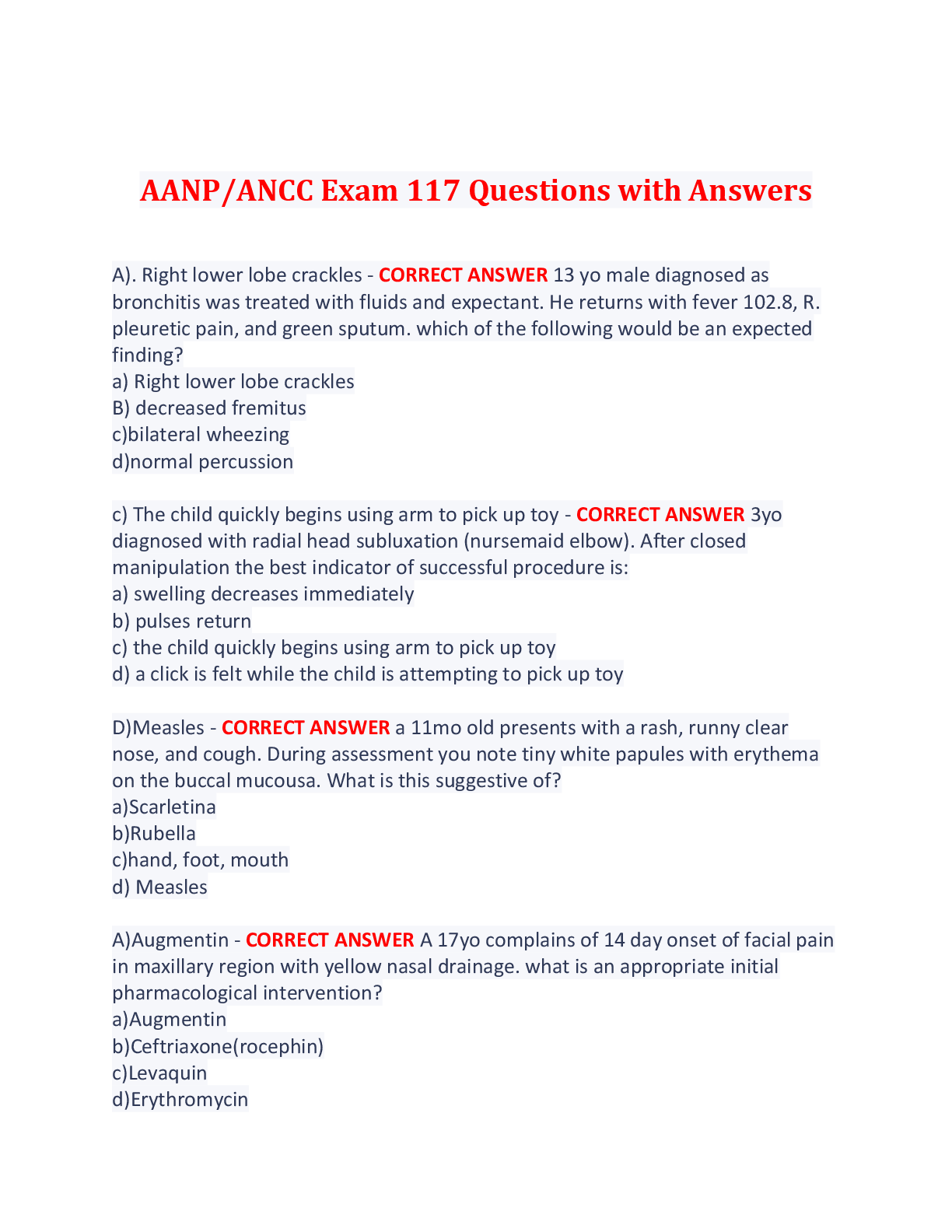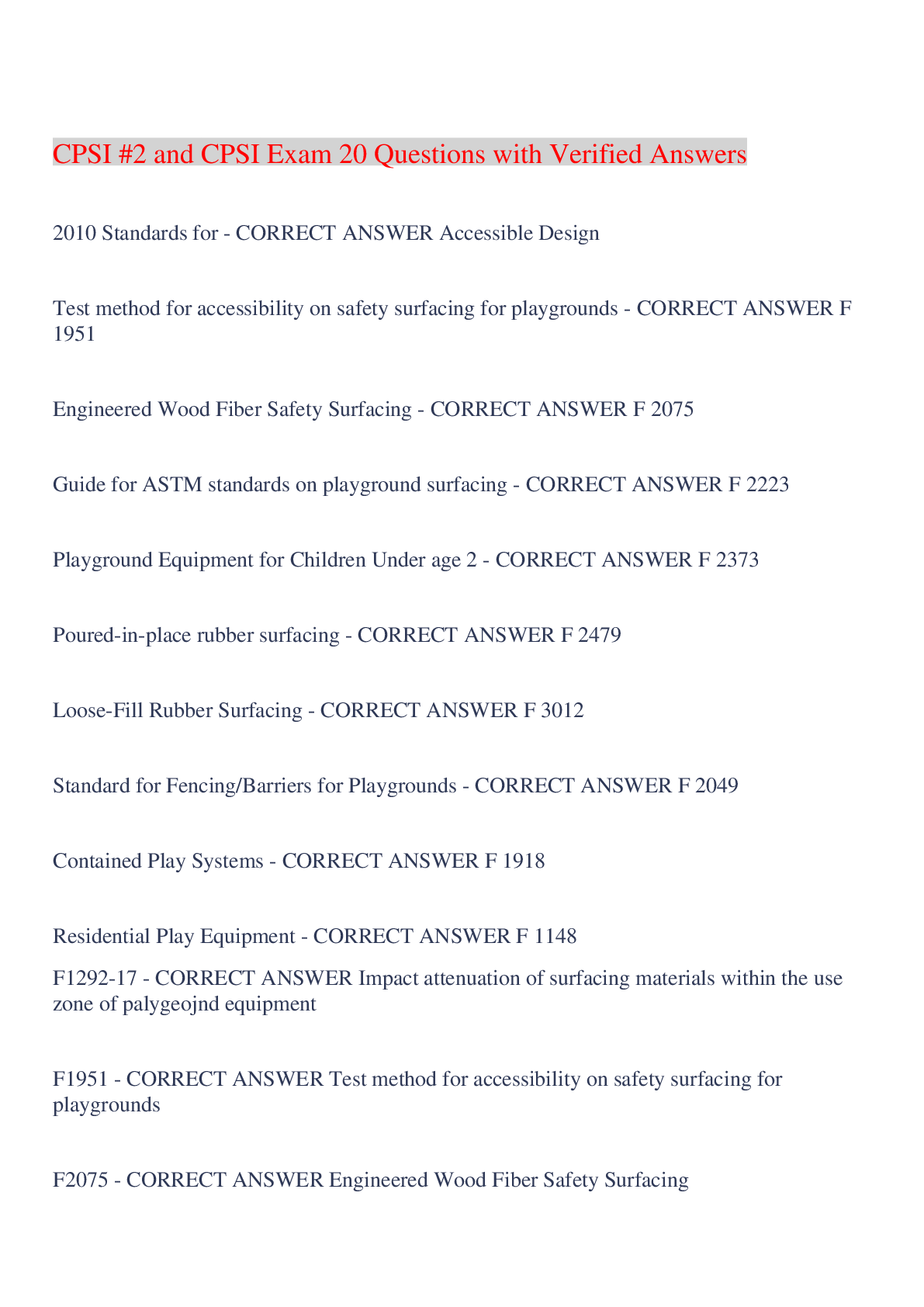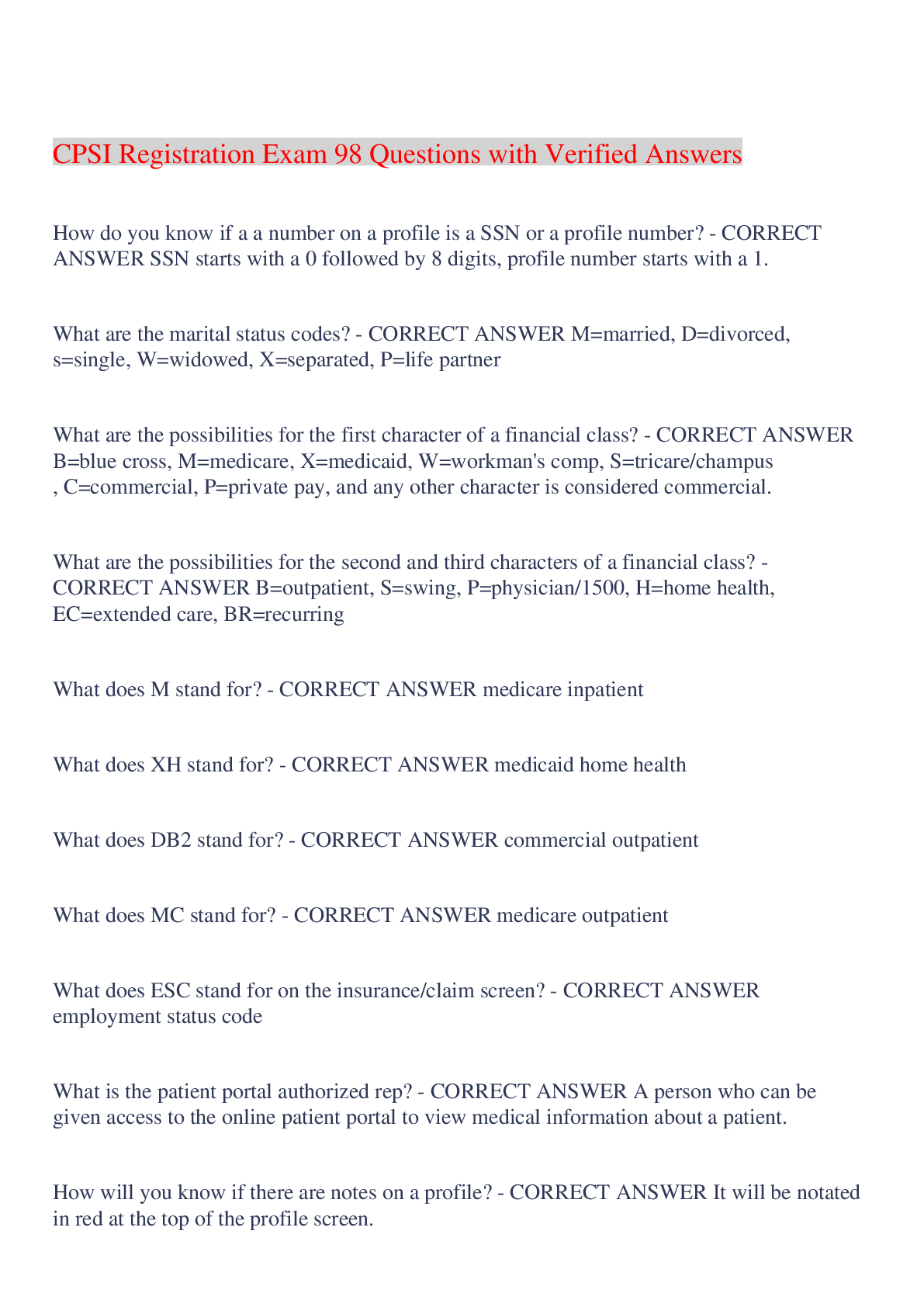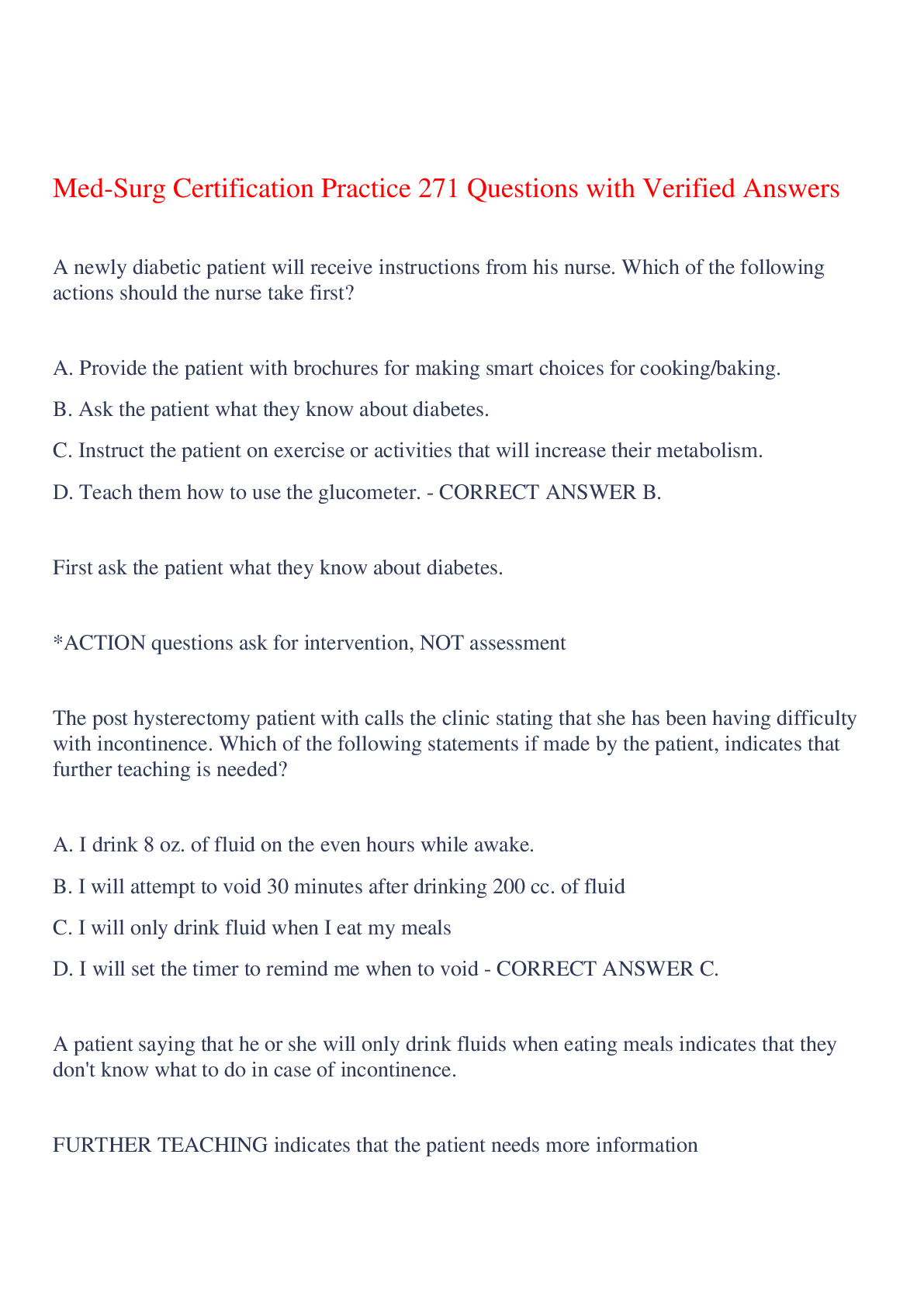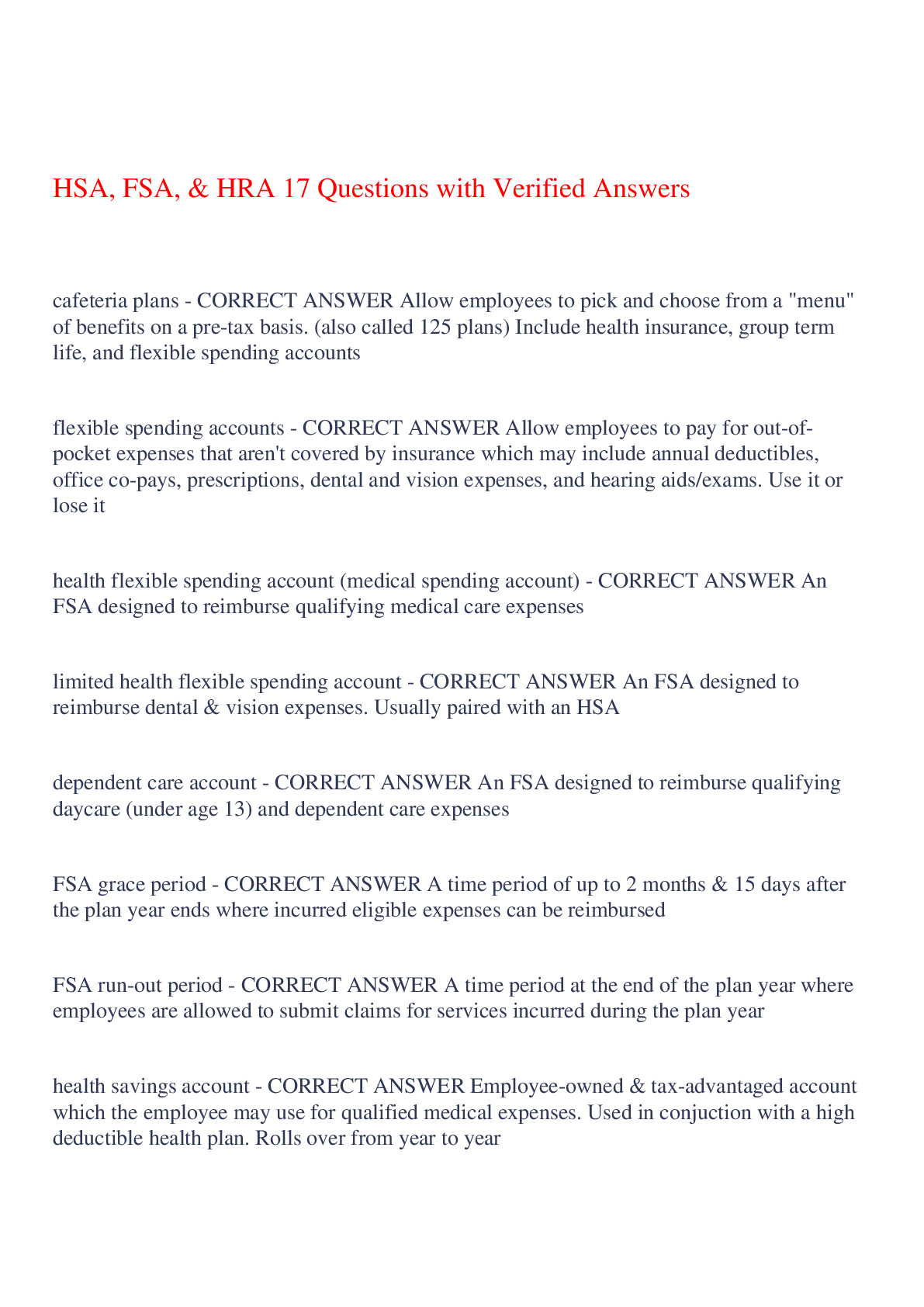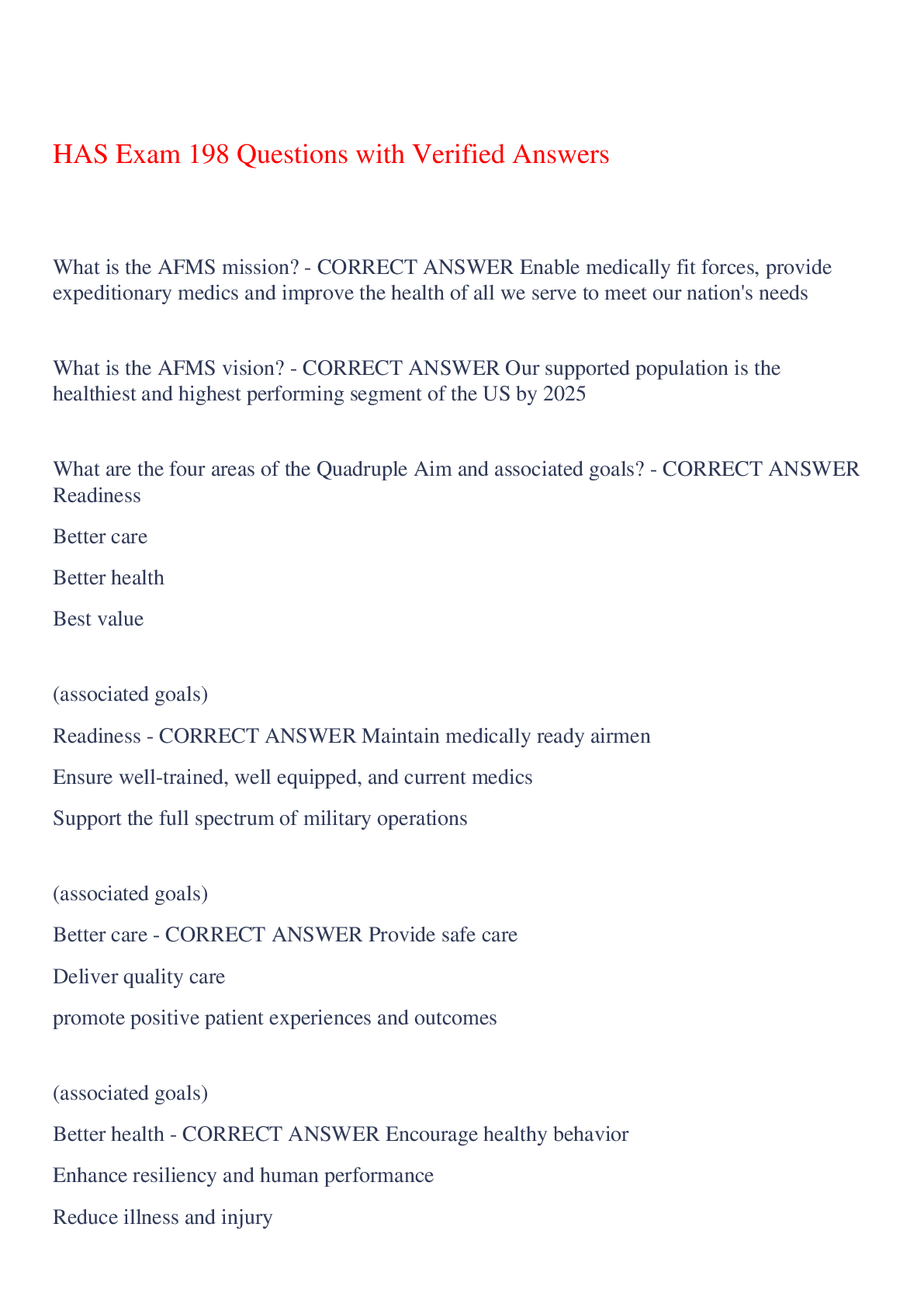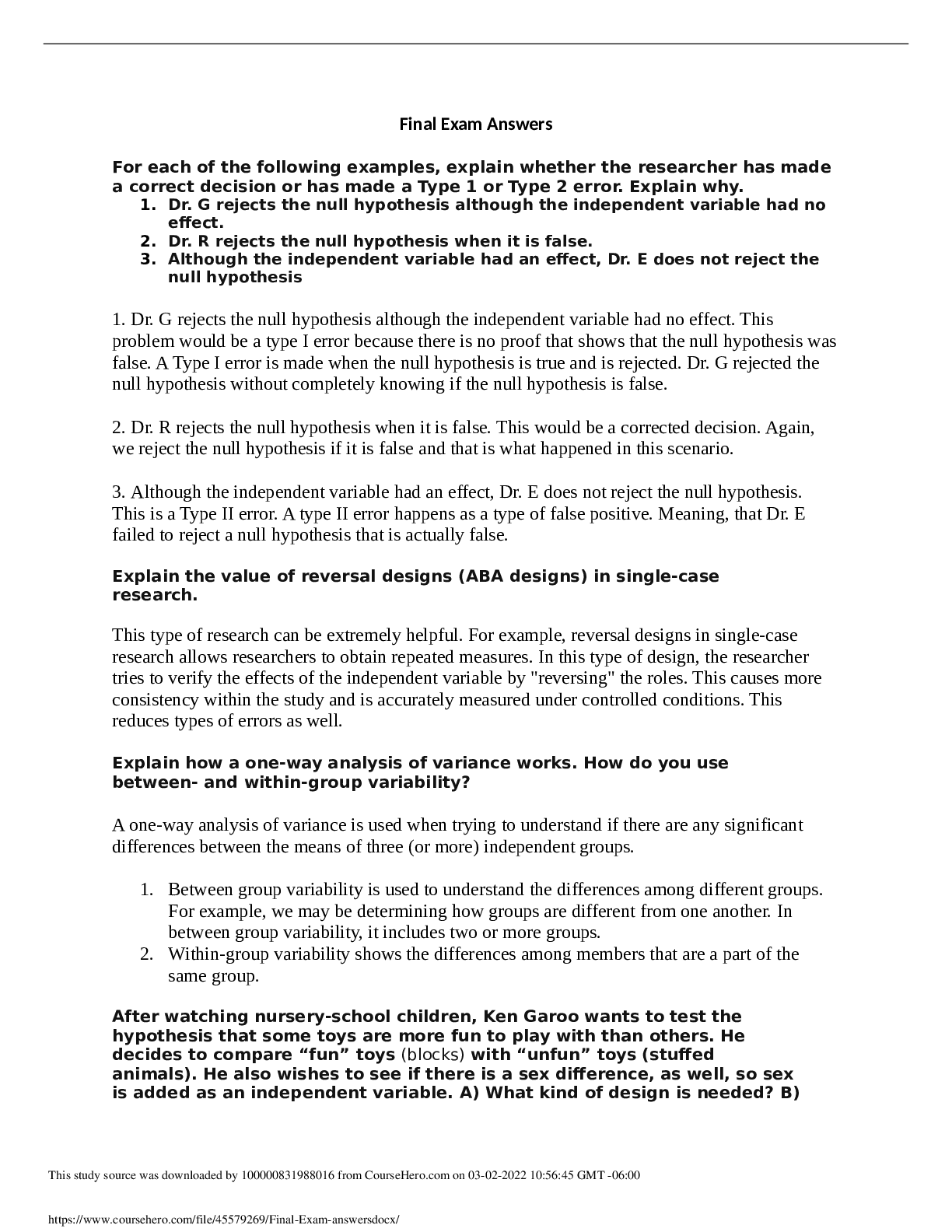CHEM 133 LESSON 7 QUIZ AND ANSWERS,100% CORRECT
Document Content and Description Below
CHEM 133 LESSON 7 QUIZ AND ANSWERS LESSON 7 QUIZ Question 1 of 25 4.0/ 4.0 Points Consider a sample of gas in a container on a comfortable spring day. The Celsius temperature suddenly doub... les, and you transfer the gas to a container with twice the volume of the first container. If the original pressure was 12 atm, what is a good estimate for the new pressure? A. 5.5 atm B. 12 atm C. 3 atm D. 6.4 atm E. 15 atm Feedback: See Chapter 09 Question 2 of 25 4.0/ 4.0 Points A gas sample is heated from -20.0°C to 57.0°C and the volume is increased from 2.00 L to 4.50 L. If the initial pressure is 0.109 atm, what is the final pressure? A. 0.188 atm B. 0.0371 atm C. 0.0632 atm D. 0.320 atm E. –0.138 atm Feedback: See Chapter 09 Question 3 of 25 4.0/ 4.0 Points At constant temperature, the volume of the container that a sample of nitrogen gas is in is doubled. As a result, the pressure of the nitrogen gas is halved. The amount of nitrogen gas is unchanged in this process. This is an example of: A. Avogadro's Law B. Charles' Law C. Gay-Lussac's Law D. Boyle's Law E. Dalton's Law Feedback: See Chapter 09 Question 4 of 25 4.0/ 4.0 Points When 0.72 g of a liquid is vaporized at 110°C and 0.967 atm, the gas occupies a volume of 0.559 L. The empirical formula of the gas is CH2. What is the molecular formula of the gas? B. CH2 C. C2H4 D. C4H8 Feedback: See Chapter 09 Question 5 of 25 4.0/ 4.0 Points A physics experiment is conducted at a pressure of 14.0 kPa. What is this pressure in mmHg? A. 18.4 mmHg B. 1.87 mmHg C. 105 mmHg D. 1.84 x 10–2 mmHg E. 1.40 x 104 mmHg Feedback: See Chapter 09 Question 6 of 25 4.0/ 4.0 Points A sample of pure oxygen gas has a pressure of 795 torr. What is the pressure of the oxygen in units of atmospheres? A. 0.760 atm B. 1.05 atm C. 1.01 atm D. 0.795 atm E. 0.604 atm Feedback: See Chapter 09 Question 7 of 25 4.0/ 4.0 Points Which conditions of P, T, and n, respectively, are most ideal? A. low P, low T, low n B. high P, low T, high n C. low P, high T, low n D. low P, high T, high n E. high P, high T, high n Feedback: See Chapter 09 Part 2 of 4 - Part 02 24.0/ 24.0 Points Question 8 of 25 4.0/ 4.0 Points Which of the following has a ΔH°f = 0 kJ/mol? A. O3(g) B. NH3(aq) D. CO2(g) E. Cl-(aq) Feedback: See Chapter 05 Question 9 of 25 4.0/ 4.0 Points An endothermic reaction causes the surroundings to A. warm up. B. condense. C. release CO2. D. become acidic. E. decrease in temperature. Feedback: See Chapter 05 Question 10 of 25 4.0/ 4.0 Points 30.0 mL of pure water at 282 K is mixed with 50.0 mL of pure water at 328 K. What is the final temperature of the mixture? A. 397 K B. 46 K C. 311 K D. 610. K E. 305 K Feedback: See Chapter 06 Question 11 of 25 4.0/ 4.0 Points Which of the following has a ΔH°f = 0 kJ/mol? A. H2O(l) B. NO(g) D. CS2(l) E. Fe2+(aq) Feedback: See Chapter 05 Question 12 of 25 4.0/ 4.0 Points A 100. mL sample of 0.200 M aqueous hydrochloric acid is added to 100. mL of 0.200 M aqueous ammonia in a calorimeter whose heat capacity (excluding any water) is 480. J/K. The following reaction occurs when the two solutions are mixed. HCl(aq) + NH3(aq) → NH4Cl(aq) The temperature increase is 2.34°C. Calculate ΔH per mole of HCl and NH3 reacted. A. -154 kJ/mol B. 1.96 kJ/mol C. 485 kJ/mol D. -1.96 kJ/mol E. 154 kJ/mol Feedback: See Chapter 05 Question 13 of 25 4.0/ 4.0 Points What temperature will the water reach when 10.1 g CaO is dropped into a coffee cup containing 157 g H2O at 18.0°C if the following reaction occurs? CaO(s) + H2O(l) → Ca(OH)2(s) ΔH°rxn = –64.8 kJ/mol Assume that the cup is a perfect insulator and that the cup absorbs only a negligible amount of heat. (the specific heat of water = 4.18 J/g•°C) A. 42.2°C B. 311°C C. 35.8°C D. 18.0°C E. 117°C Feedback: See Chapter 05 Part 3 of 4 - Part 03 24.0/ 24.0 Points Question 14 of 25 4.0/ 4.0 Points I have a sealed cylinder in my lab that contains 250 L of gas. If I keep temperature the same and decrease the volume to 125 L, what should I expect to happen? A. The pressure will double B. there will be half as much pressure C. Gases are incompressible, so the volume could not be changed D. The pressure will not change Feedback: The volume is directly proportional to the absolute temperature (K) for a fixed amount of an ideal gas at constant pressure. Question 15 of 25 4.0/ 4.0 Points The partial pressure of oxygen gas in our atmosphere is 0.21 atm. This is the partial pressure at which human lungs have evolved to be able to breathe this gas. A SCUBA diver, will thus still have to breath oxygen at this pressure even when diving way down in the water. If a mixture of helium and oxygen (heliox) in his tank is at a pressure of 7.00 atm, what must the partial pressure be of helium to keep the partial pressure of oxygen at 0.21 atm? A. 7.00 atm B. 7.21 atm C. 0.21 atm D. 6.79 atm Feedback: The total pressure exerted by a mixture of gases is equal to the sum of the partial pressures of the individual component gases. Question 16 of 25 4.0/ 4.0 Points I have a cylinder sitting in my lab that contains 1.55 L of gas, and it's temperature is 305.15 K. If I compress the cylinder and change the volume to 0.755 L, what will be the new temperature in Celsius? A. -124°C B. 273°C C. 149°C D. 353°C Feedback: The volume is inversely proportional to the pressure for a fixed amount of an ideal gas at constant temperature. Question 17 of 25 4.0/ 4.0 Points If I have a cylinder that holds 10.7 L of gas at 298 K, how many liters of gas could it hold at 352 K? A. 12.6 L B. 578 L C. 9.06 L D. 91.3 L Feedback: The volume is directly proportional to the absolute temperature (K) for a fixed amount of an ideal gas at constant pressure. Question 18 of 25 4.0/ 4.0 Points `I have a cylinder sitting in my lab that contains 0.500 L of 25.85 oC gas, and it's pressure is 14.7 psi. If I push the cylinder and increase the pressure to 22.6 psi and the temperature to 59.85 oC, what will be the new volume of the gas in L? A. 1.45 L B. 0.362 L C. 2.77 L D. 0.691 L Feedback: The PV product divided by the absolute temperature (K) is constant for a fixed amount of an ideal gas at constant volume. Question 19 of 25 4.0/ 4.0 Points `The air that we breathe is actually a mixture of several gases. Of those involved, which is the third most abundant component of the mixture? A. argon B. carbon dioxide C. oxygen D. smog E. nitrogen Feedback: The total pressure exerted by a mixture of gases is equal to the sum of the partial pressures of the individual component gases. Part 4 of 4 - Part 05 20.0/ 24.0 Points Question 20 of 25 4.0/ 4.0 Points How much heat is released when 6.00 g of methane is combusted using the reaction below? CH4 + 2O2 → CO2 + 2H2O ΔHrxn = -890. kJ A. 334 kJ B. -334 kJ C. -8.54 x 104 kJ D. 8.54 x 104 kJ Feedback: The balanced thermochemical reaction equation relates the change of energy to moles. We first convert the amount to moles and then use stoichiometry to determine the energy change. Question 21 of 25 4.0/ 4.0 Points Magnesium oxidizes via the reaction: 2 Mg + O2 → 2 MgO The reaction has a △Hrxn = -1203 kJ. How much heat (in kJ) is released when you completely react 3.000 moles of O2? A. -401.0 kJ B. -1203 kJ C. -2406 kJ D. -3609 kJ Feedback: The balanced thermochemical reaction equation relates the change of energy to moles. We first convert the amount to moles and then use stoichiometry to determine the energy change. Question 22 of 25 4.0/ 4.0 Points Methanol is an ingredient in windshield washer fluid and ingesting as little as 4 mL can cause blindness in humans. In the reaction below, methanol is produced from carbon dioxide and hydrogen gas. If the reaction has a △H rxn = -128 kJ, how much heat is released when 16.8 g CO is reacted? CO + 2 H2 → CH3OH A. -76.8 kJ B. -128 kJ C. -16.8 kJ D. -0.600 kJ Feedback: The balanced thermochemical reaction equation relates the change of energy to moles. We first convert the amount to moles and then use stoichiometry to determine the energy change. Question 23 of 25 4.0/ 4.0 Points N2 is non-reactive, however, if you can get it to react with H2, it does so in a 1:3 mole ratio (N2:H2) and releases 92.0 kJ of thermal energy. That means which if these statements are true? A. All of the above are true. B. This reaction is exothermic. C. This reaction has a negative enthalpy of reaction. D. This reaction has a negative enthalpy of reaction. Feedback: Exothermic chemical reactions release energy. More energy is released when the bonds are formed in the products than is used to break the bonds in the reactants. Endothermic chemical reactions that absorb energy. More energy is absorbed when the bonds in the reactants are broken than is released when new bonds are formed in the products. Question 24 of 25 4.0/ 4.0 Points One way to produce methanol: CO + 2 H2 → CH3OH This reaction has a △H rxn = -128 kJ. How much heat (in kJ) is released when you completely react 4.04 g CO? A. -128 kJ B. -517 kJ C. -14500 kJ D. -18.5 kJ Feedback: The balanced thermochemical reaction equation relates the change of energy to moles. We first convert the amount to moles and then use stoichiometry to determine the energy change. Question 25 of 25 0.0/ 4.0 Points Combustion of hydrogen releases 142 kJ/g of hydrogen reacted. How many kJ of energy are released by the combustion of 16.0 oz of hydrogen? (1 lb = 16 oz; 1 kg = 2.2 lb) A. 2.69 × 105 kJ B. 1.31 kJ C. 19.2 kJ D. 64.5 kJ Feedback: In multistep unit conversion problems, the given unit is canceled and in each successive step the next unit in the sequence is produced, each canceling out until only the unit needed in the answer is left. [Show More]
Last updated: 2 years ago
Preview 1 out of 8 pages

Buy this document to get the full access instantly
Instant Download Access after purchase
Buy NowInstant download
We Accept:

Reviews( 0 )
$14.00
Can't find what you want? Try our AI powered Search
Document information
Connected school, study & course
About the document
Uploaded On
Dec 17, 2021
Number of pages
8
Written in
Additional information
This document has been written for:
Uploaded
Dec 17, 2021
Downloads
0
Views
113


